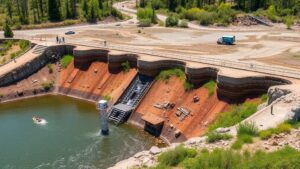Recovering Evidence of Early Settlements Along Ancient Riverbanks
Recovering Evidence of Early Settlements Along Ancient Riverbanks
The study of early human settlements along ancient riverbanks provides significant insights into the socio-cultural, economic, and environmental dynamics of historic civilizations. Rivers, as vital resources, dictated settlement patterns and facilitated agricultural productivity, trade, and transportation. This article explores the methodologies employed in recovering evidence of these settlements, the archaeological significance of riverbank sites, and notable case studies illustrating successful investigations.
The Importance of Riverbanks in Early Settlements
Ancient riverbanks served as strategic locations for early human communities. availability of freshwater resources, fertile land for agriculture, and pathways for transportation made these areas attractive for settlement. Archaeologists emphasize that rivers not only shaped the physical landscape but also the cultural and economic frameworks of early civilizations. Key reasons for riverbank settlement include:
- Access to Water: Freshwater is essential for drinking, agriculture, and livestock maintenance.
- Fertile Soil: Riverbanks often feature alluvial soil, which is highly productive for cropping.
- Trade Routes: Rivers served as natural highways for the movement of goods and people.
These factors combined to create flourishing communities that played crucial roles in early human development.
Methodologies in Recovery of Archaeological Evidence
Recovering evidence of early settlements along riverbanks involves a variety of archaeological methodologies. Here, we outline some of the key techniques utilized by researchers:
- Survey Techniques: Systematic surveys are employed to identify the distribution of artifacts and features along riverbanks. Techniques such as remote sensing and aerial photography are also invaluable in revealing patterns invisible to the naked eye.
- Excavation: Stratigraphic excavation digs down through layers of sediment to uncover artifacts, structures, and ecofacts that can indicate human presence and activity.
- Geoarchaeology: Examining sediment layers and soil composition provides insight into past environmental conditions, helping to contextualize human activity within broader climatic changes.
These methods can be complemented by modern technological advancements, including Geographic Information Systems (GIS) for spatial analysis, and soil analysis techniques to address questions of land use.
Case Studies: Riverbank Archaeology in Action
Several significant case studies illustrate the importance of riverbanks in recovering evidence of early settlements. Two notable examples stand out:
The Indus Valley Civilization
One of the world’s earliest urban civilizations, the Indus Valley, thrived along the banks of the Indus River around 2500 BCE. Archaeological excavations at sites like Mohenjo-Daro and Harappa have revealed well-planned cities, sophisticated drainage systems, and evidence of trade. Studies highlight how access to the river facilitated agricultural development and trade networks, positioning the Indus Valley as a central hub in early civilization history.
The Nile River Valley
The Nile River has been critical to the sustenance and development of ancient Egyptian civilization. Evidence from sites like Hierakonpolis shows how settlers strategic placement along the river led to advancements in agriculture and urban planning. rich floodplain allowed for reliable crop production, enabling population growth and prosperity. Excavation in this region has uncovered artifacts such as pottery and tools that date back thousands of years, illuminating aspects of daily life and societal organization.
Conclusion
Recovering evidence of early settlements along ancient riverbanks is crucial for understanding the development of human societies. These areas not only provide insights into agricultural practices and trading relationships but also help us apprehend how environmental factors influenced cultural evolution. As technology advances, so too do the methods for uncovering this rich history. Archaeological efforts continue to reveal the intricate relationship between rivers and early settlements, underscoring the essential role these waterways played in shaping human civilization.
Actionable Takeaways
- Recognize the pivotal role of riverbanks in early settlement patterns, particularly for access to resources.
- Stay informed about technological advancements aiding archaeology, as they enhance recovery methods.
- Engage with archaeological findings to appreciate the complexity of ancient civilizations and their environments.


